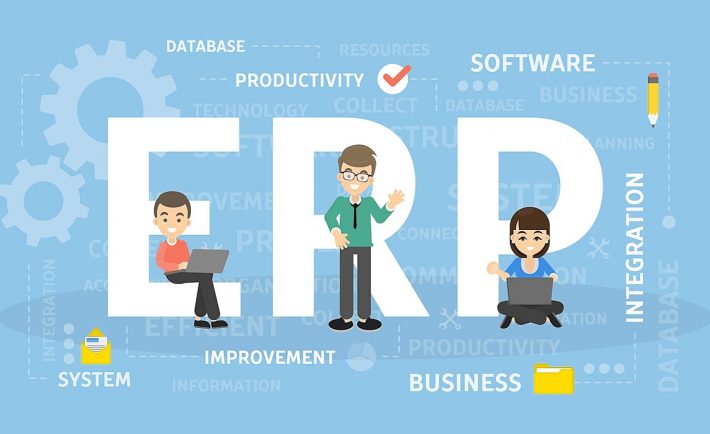
According to Investopedia, Enterprise Resource Planning (ERP) is “a process used by companies to manage and integrate the important parts of their businesses”. It’s oriented on the continuous optimization of enterprise resources through a specialized suite of software that provides a common model for all areas of activity.
The concept of ERP was formed in 1990 by Lee Wylie (analyst in the Gartner company). In around 5 years, the first successful ERP systems began to appear (for example, Baan, Oracle, PeopleSoft, JD Edwards). In 2000, many ERP systems were developed for small and medium-sized enterprises. The most famous of them are Sage Group and Microsoft. Nowadays, the implantation of an ERP system is a prerequisite for a public company and is operated not only by industrial enterprises (like it was in 1990s), but also by most large organizations, regardless of country, form of ownership, and industry.
A web-based ERP system is delivered via the Internet using HTTP instead of using inbuilt device’s memory. The web-based software almost always runs inside a web; in rare cases, it may have a desktop version as well.
Understanding the ERP System

In simple words, the ERP system can be considered as a remedy that interconnects different computer systems. Without this system, each department is optimized only for one dedicated work. Nevertheless, the ERP system doesn’t deprive the departments of their own system, but creates the possibility of accessing any system via one app.
ERP apps also gather information about each department and make it available for other departments that can use this information to increase productivity. Such communication between the departments is very beneficial for large organizations. It helps eliminate unnecessary waste of money and ineffective technologies.
The ERP system is employed for various needs: to expand the business, optimize the working processes, reduce costs, and others.
Advantages of ERP System Development
The implementation of the ERP system and the usage of the ERP software help improve such aspects as:
- Productivity and accuracy
The ERP system makes it possible to link similar processes together which allows improving productivity and accuracy for achieving great results in shorter terms.
- Planning and reporting
Timely data reports let the companies perform better planning of business processes and budget and make predictions, as well as report the current status of all operations to shareholders.
- Budget optimization
ERP systems allow for quick access to the important information to all interested parties. This contributes to quicker response rates and better efficiency which, in its term, allows decreasing the company’s costs.
- Concentration on more important tasks
Thanks to the elimination of secondary tasks, the employees can focus on more important tasks.
How to Build a Web Based ERP System: Step-by-Step Guide
Before we proceed to our guide on how to create a web based ERP system, it’s important to understand that ERP system will be effective only if it’s implemented carefully. NetSuite (owned by Oracle) claims that in 2019, about 67% of ERP system implementations have been successful. 33% of companies have failed. So, as you can see, the development of ERP system is a very serious process and it’s important to strictly follow every step of the process.
Step 1. Determine your goals and objectives.
This step may seem easy at first, but making your goals and objectives clear for everyone involved in the process is quite a challenge. Neglecting it, you may waste the valuable time on ineffective processes and pick the wrong priorities. To bring the most benefit to your project, you should make sure that your objectives go on par with your business strategy.
Remember that ERP is a tool that you are using for getting better results. By doing so, you will align your goals with the business strategy. Think about your objectives as a way to achieve your goals.
Key tips to make your goals achievable:
- Determine what exactly you want from the ERP system.
- Keep track of your progress.
- Make sure that you have enough resources to achieve your goals.
- Set strict deadlines to complete each step.
Step 2. Involve stakeholders from the very beginning
People who will pay for your product and people who will be using it are an important part of the management. Their opinion and desires are very important for every step of the process. That is why stakeholders must be involved on initial steps. Their knowledge and influence are an extremely important part of your success.
Step 3. Modernize the processes in your company
Make sure that you are on the right path:
- Your clients are satisfied with the service.
- Your products are of a high quality.
- All the processes are effective.
If not, the implementation of the ERP system will only worsen everything. This way, you need to modernize some processes prior to creating custom ERP software. However, this step may not be so important for young companies that tend to change their processes for optimization.
Step 4. Make sure that your developers are aware about each process.

The ERP developers are those people who can create the greatest vision of your custom ERP system, bringing your project to a whole new level. That is why you must give them enough information. You can do it by describing everything to the project manager that then will bring that information to the developers.
Step 5. Define functions and design of your web-based ERP software.
Finally, it’s time to talk about the technical part of ERP software development. Nail the list of functions you want to add to your software. This will allow you to get the first vision of the system you want to get. Those who are not very familiar with the enterprise resource planning (ERP) may firstly develop a plan. Prior to this, you may study ERP systems of other companies. Note that in large companies, the creation of a feasible plan requires involving representatives of each department.
Your plan should include:
- Modules that your ERP system should have.
- Required resources.
- Established deadlines.
Create wireframes to transfer your vision to reality. It will allow you to see how the software looks and what it does. The wireframes may be scrutinized by stakeholders and then used as the interface. You can also create prototypes and discuss them with stakeholders, but it’s a more difficult and time-consuming way to go.
Step 6. Define tools for your developers.
- Choose where your system will be hosted (cloud or local server).
- Determine programming language for front-end and back-end (Node.js, for example).
- Select database to store company’s data. The SQL database will work best for small companies, and the NoSQL is a good choice for those requiring flexibility as it allows storing data in many formats.
Step 7. Use your existing software to create a custom web-based ERP software.
If you have used some other tools before, the development team can connect them via API to your future ERP system in order to integrate the existing functionality. Thanks to that, you can save both time and money. Plus, you won’t lose the data that you collected while using the other service as everything will be transferred to your custom ERP system without loss.
Step 8. Test your ERP system.
- Check if the existing system is compliant with your initial goals and requirements.
- Make sure that all the functions work as intended and give accurate results.
- Organise the testing process of all the modules. Resort to help of people from each department for that and ask them for feedback.
- Test the security to spot weaknesses in the system and prevent data leakage.
The Best Example of ERP Solutions Providers

These successful ERP systems may inspire you to develop custom ERP software and give you some ideas. Maybe your development will become as successful as these ready-to-go solutions:
- SAP (System Application and Product in Processing). This is the largest company on the ERP market. It has many (more than 300 thousand) clients from all around the world in spite of the fact that the company offers high-priced products. The company is extremely successful and uses universal ERP modules.
- Oracle. It’s the second largest company on the market with an experience of more than 30 years. It uses flexible, easy-to-customize modules that are also very costly.
- Infor. The company is the third one on the ERP market. It has been on the market for 20 years. Infor was the first one to introduce ERP solutions for financial systems, supply-chain and CRM. The company has more than 70 thousand clients and its products are low-priced.
- Microsoft. The company has a very strong ERP channel network. Its ERP products are sold only via resellers for an added price. It has more than 80 thousand customers from all parts of the world.
- Epicor. This company is one of the oldest ones on the ERP market (founded in 1972) and has built a great reputation for many of its products. Now, it has more than 20 thousand clients worldwide and its success keeps on growing each year. It works with ERP consultants and offers moderately-priced products.
- Sage Intacct. The products offered by this company are great for financial management and e-commerce projects. Its ERP software has a large number of reporting and accountability functions and allows adding new features. The products are offered for average price.
Cloud Based ERP and Web-Based ERP vs On-Premise ERP: Key Difference
A cloud-based and web-based ERP software can be accessed via a web browser. This software is hosted on the cloud, which means you don’t need to run a physical server to host the application. Such systems are priced under monthly or annual subscriptions and may include some additional fees. The best thing about web-based ERP systems is that you always access the latest version of the software – there’s no need to download and install updates to access newly developed functionality.




